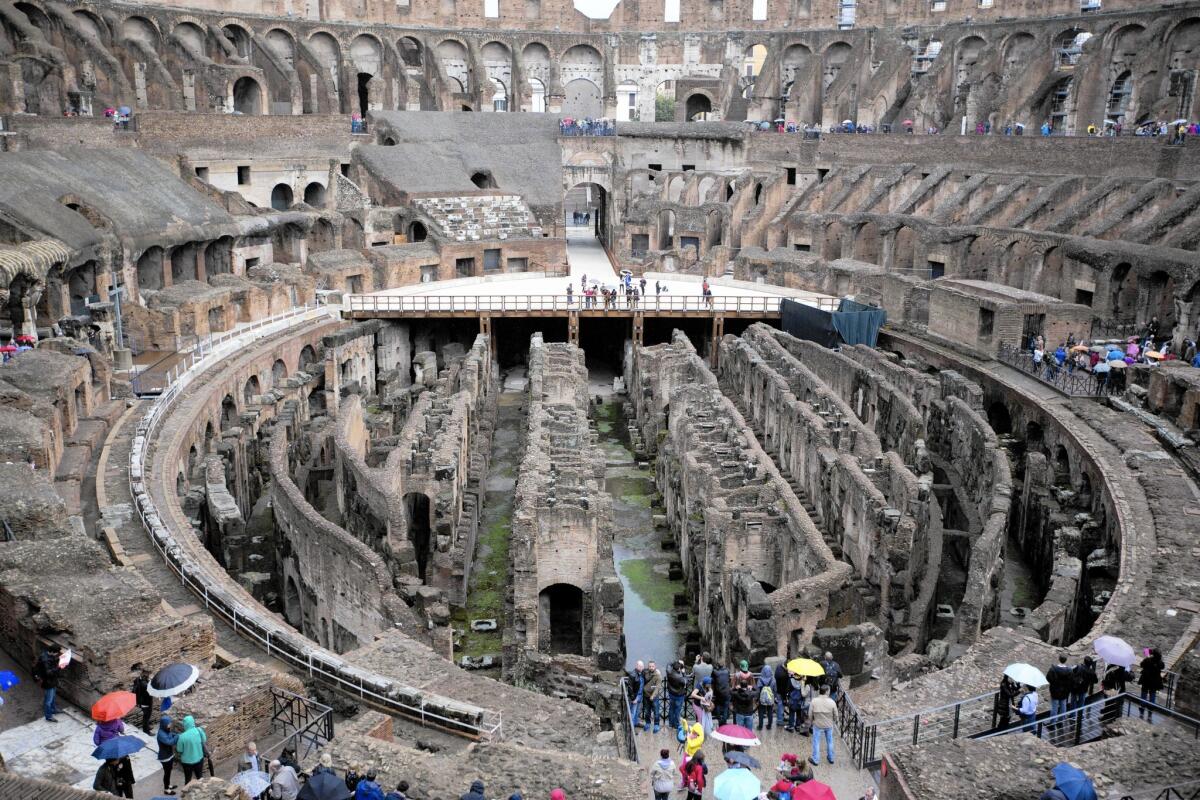Rome officials consider reinstalling floor of Colosseum

Reporting from Rome — In a subterranean corridor of the Colosseum, a guide pointed to an innocuous-looking lead plate fixed to the floor.
“That once formed part of a pulley system, operated by 16 men, that hoisted wild animals in a cage up through a trapdoor in the arena above during gladiatorial shows,” he said.
A few yards on, the guide stopped again by a dark, cavernous space where boats once lined up to enter the arena when it was flooded for mock naval battles.
In a city of iconic structures, the cylindrical Colosseum looms large, its arched tiers a symbol of ancient Rome. But only when you get up close do you appreciate the staggering efforts that went into keeping 35,000 bloodthirsty Romans entertained almost two millenniums ago.
This month Rome has been talking about bringing regular, less bloody, shows back to the Colosseum, thanks to a tweet by Italy’s culture minister, Dario Franceschini, in which he backed the idea of resurfacing the full surface of the ancient oval arena.
“All it will take is a bit of courage,” he tweeted.
Franceschini was echoing the sentiments of Italian archaeologist Daniele Manacorda, who has urged construction of a new surface over the excavated remains of the two-story warren of corridors and chambers beneath the arena, from which animals and scenery could be raised through any one of 80 trapdoors dotted around the original wood floor.
That floor was removed in the 6th century after the last gladiator battles were staged, before the basement was filled in with earth.
Today, visitors look straight down into the excavated, labyrinthine basement area and struggle to get a feel for where the gruesome fighting took place.
Though not calling for the return of full-blown gladiators, Manacorda said “contemporary events” could be held, spurring U.S. investor James Pallotta, owner of pro soccer team AS Roma, to boast that he could draw millions of viewers for a pay-per-view soccer match in the arena.
Franceschini scotched that idea last week, but did suggest plays and classical music concerts, which, with an “intelligent” reconstruction of the arena, could raise vital funds for upkeep of the monument.
Opened in AD 80, the Colosseum held its last gladiator battle in AD 508, according to the Colosseum’s director, and it was later used as temporary housing, a fort, even a place of worship thanks to an in-house chapel — not to mention as a hangout for prostitutes who once loitered under the street-level arches.
The arches were so handy for liaisons that scholars believe the Latin word for “arch” — fornix — gave us the word “fornicate.”
In the 1800s, archaeologists began to excavate the corridors under the arena, digging up half of it, though they left enough for fascist dictator Benito Mussolini to hold rallies in the Colosseum and for Roman waiters to stage races around it, dressed in white coats and holding laden trays.
“Let’s say it’s always been lived in,” said Colosseum director Rossella Rea, who is overseeing an overdue scrubbing — with brushes as small as toothbrushes — of the pollution encrusted on the arches.
In the 1990s, a section of wooden floor was laid over the basement corridors, replicating a third of the original arena floor. The space has been used for a handful of small concerts, including one by Paul McCartney, who played for 400 people in 2003.
Now, if Franceschini gets his way, that floor will be extended to cover the entire arena, allowing larger events.
But one concern, Rea said, is how many visitors would then be able to see the old animal chambers, pulley systems and boat docks. Visitors would have to climb down steps underneath a new arena floor to get a look at them.
“We can only take groups of 25 down at a time, so of the 24,000 visitors we get a day in peak times, very few would be able see the corridors if they are covered over,” Rea said. “And that’s a shame, because after being buried for centuries, they are the best-preserved part of the Colosseum, a monument within a monument.”
Then there’s the water. Gurgling its way through the underground corridors is a stream that emerges inside the bowels of the Colosseum before disappearing into an ancient drainage pipe. At least most of the time.
“The old Roman drainage pipe was wide, but was blocked by construction of the nearby subway line,” Rea said. “A bypass pipe was installed, but it is much narrower.”
The result is that heavy rains result in flooding of the Colosseum, with water rapidly rising 18 feet, right up to the level where Franceschini wants the new arena floor.
Fixing that, said Rea, would involve widening the water pipes, an expensive job at a time when the cash-strapped government is reduced to proposing crowd funding to pay for the upkeep of other historical sites.
Said Rea: “Tunneling down under the subway line to widen that drainage system would incur biblical costs.”
Kington is a special correspondent.
More to Read
Sign up for Essential California
The most important California stories and recommendations in your inbox every morning.
You may occasionally receive promotional content from the Los Angeles Times.








